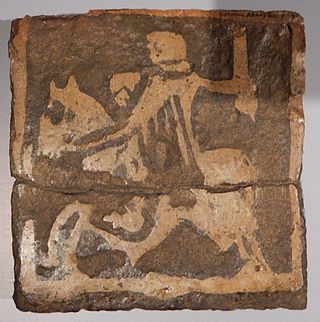
Abbotsbury Abbey, dedicated to Saint Peter, was a Benedictine monastery in the village of Abbotsbury in Dorset, England. The abbey was founded in the 11th century by King Cnut's thegn Orc and his wife Tola, who handsomely endowed the monastery with lands in the area. The abbey prospered and became a local centre of power, controlling eight manor houses and villages. During the later Middle Ages, the abbey suffered much misfortune. In the time of the dissolution of the monasteries, the last abbot surrendered the abbey and the site became the property of Sir Giles Strangways.
Sigeric was the Archbishop of Canterbury from 990 to 994. Educated at Glastonbury Abbey, he became a monk there before becoming an abbot and then Bishop of Ramsbury before his elevation to the archbishopric. An account of his pilgrimage to Rome in 990 survives and is an important source for historians studying Rome during his lifetime.
Æthelgar was Archbishop of Canterbury, and previously Bishop of Selsey.
Ordbriht was a monk at Glastonbury, Winchester, and then Abingdon until 964 when he was appointed Abbot of Chertsey by Æthelwold; Ordbriht attests as Bishop of Selsey from about 989 to 1007 or 1008.
Ælfmær was an Anglo-Saxon Bishop of Selsey.
The Abbot of Abingdon was the head of Anglo-Saxon and eventually Benedictine house of Abingdon Abbey at Abingdon-on-Thames in northern Berkshire, England.

Eynsham Abbey was a Benedictine monastery in Eynsham, Oxfordshire, in England between 1005 and 1538. King Æthelred allowed Æthelmær the Stout to found the abbey in 1005. There is some evidence that the abbey was built on the site of an earlier minster, probably founded in the 7th or 8th centuries. The site is a Scheduled Historic Monument.
Cyneweard was an Anglo-Saxon Bishop of Wells. He was a monk of Glastonbury Abbey before becoming abbot of Milton Abbey in 964. He was consecrated bishop of the Diocese of Wells in about 973 or 974, and died in office on 28 June 975. His death is mentioned in the short Old English poem "The Death of King Edgar", which occurs in the entry for 975 of two of the manuscripts of the Anglo-Saxon Chronicle.
Sigar was an Anglo-Saxon Bishop of Wells.
Merewith was an Anglo-Saxon Bishop of Wells. He was abbot of Glastonbury Abbey prior to being consecrated bishop about 1024. He died on either 11 April or 12 April 1033.
Seffrid I, sometimes known as Seffrid Pelochin, was a medieval Bishop of Chichester.
Abbot of Tavistock was the title of the abbot of Tavistock Abbey in Devon, England. The name of the first abbot is unknown, but the abbey was founded between 975 and 980. Unless otherwise specified the details in the following table are from Heads of Religious Houses: England & Wales 940–1216.

The Abbot of Gloucester was the title of the head of Gloucester Abbey in Gloucester, England.
Abbot of Battle was the title given to the abbot of Battle Abbey in Sussex, England. The abbey was founded in 1067 by William the Conqueror and the first abbot was Robert Blanchard, who drowned soon after his appointment. The following table gives the abbots from the founding of the abbey until 1216, and is from Heads of Religious Houses: England and Wales 940–1216.
The Abbot of Crowland was the head of Crowland Abbey, an English monastery built up around the shrine of Saint Guthlac of Crowland by King Æthelbald of Mercia, and refounded as a Benedictine house circa 948. The last abbot was John Wells, who was constrained to surrender the monastery to the king's agents during the Dissolution of the Monasteries in 1539.
The Chronicon Abbatiae de Evesham or Chronicle of the Abbey of Evesham, sometimes the Evesham Chronicle, is a medieval chronicle written at and about Evesham Abbey in Worcestershire in western England.
The Abbot of Evesham was the head of Evesham Abbey, a Benedictine monastery in Worcestershire founded in the Anglo-Saxon era of English history. The succession continued until the dissolution of the monastery in 1540.
The Abbot of Burton was the head of Burton Abbey, the Benedictine monastery of St Mary and St Modwenna at Burton-upon-Trent in Staffordshire, England. Allegedly the church was begun by a wandering Irish holy woman, but it was actually founded c. 1003 as a Benedictine abbey by Wulfric Spott. A continuous series of abbots, which slight possible interruptions, can be traced thereafter until the English Reformation.
Adam of Eynsham was a medieval English chronicler and writer. He was a monk and Abbot of Eynsham Abbey.

Ralph Gubion was a native Englishman and abbot of St Albans Abbey from 1146 to 1151.